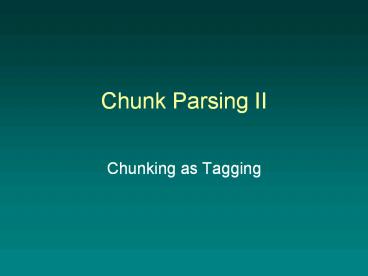Chunk Parsing II - PowerPoint PPT Presentation
Title:
Chunk Parsing II
Description:
'Shallow parsing has become an interesting alternative to full parsing. The main goal of a shallow parser is to divide a text into segments which ... – PowerPoint PPT presentation
Number of Views:86
Avg rating:3.0/5.0
Title: Chunk Parsing II
1
Chunk Parsing II
- Chunking as Tagging
2
Chunk Parsing
- Shallow parsing has become an interesting
alternative to full parsing. The main goal of a
shallow parser is to divide a text into segments
which correspond to certain syntactic units.
Although the detailed information from a full
parse is lost, shallow parsing can be done on
non-restricted texts in an efficient and reliable
way. In addition, partial syntactical information
can help to solve many natural language
processing tasks, such as information extraction,
text summarization, machine translation and
spoken language understanding. - Molina Pla 2002
3
Molina Pla
- Definitions
- Text chunking dividing input text into
non-overlapping segments - Clause identification detecting start and end
boundaries of each clause - What are the chunks of the following? What are
the clauses? - You will start to see shows where viewers
program the program.
4
Molina Pla
- Chunks
- Clauses
5
Chunk Tags
- Chunks and clauses can be represented using tags.
- Sang et al 2000s tags
- B-X first word of a chunk of type X
- I-X non-initial word of chunk
- O words or material outside chunks
6
Chunk Tags
- You will start to see shows where viewers
program the program.
7
Chunk Tagging
- HMMs can be applied to tagging.
- HMM tagger, maximize (iinput words, ooutput
tags) - But how do you train an HMM Chunk Tagger? What
should its training data look like? (What are
the is?)
8
Tagging
- From Molina and Pla
- POS tagging considers only words as input.
- Chunking considers words and POS tags as input.
- Clause identification considers words, POS tags
and chunks as input. - Problem vocabulary could get very large and the
model would be poorly estimated.
9
Molina Pla
- Solution
- Enrich chunk tags by adding POS information and
selected words - Describe specialization function fs on the
original training set T to produce a new set T,
essentially transforming every training tuple
ltij, ojgt to ltij, ojgt - Training then done over the new training set
10
Molina and Pla
- Examples
- ltYou?PRP, B-NPgt ? ltPRP, PRP?B-NPgt
- Considering only POS information
- ltwhere?WRB, B-ADVPgt ? ltwhere?WRB,
where?WRB?B-ADVPgt - Considering lexical information as well
11
Molina and Pla
12
Molina Pla
- Training process
- Tag corpus to get the word and tag associations.
The words and tags become the new input (e.g.,
You?PRP, where?WRB) - Chunk a portion of the corpus using Sang et al
(2002) chunk tag outputs. These are the new
outputs (e.g., B-NP, I-NP, ) - Apply specialization function across the training
corpus to transform the training set - Train HMM Tagger on transformed set
13
Molina Pla
- Tagging
- POS tag a corpus
- Apply trained tagger against POS tagged corpus.
- Take into account input transformations done in
fs - Map relevant information in input to modified
output O - Map output tags O back to O.
14
Molina and Pla
- Give brief discussions of other approaches to
chunking - Compare the relative performances of the other
systems - Compare systems with different specialization
functions (different fS) - BTW, they used the TNT tagger developed by
Thorsten Brants, which can be downloaded from the
Web http//www.coli.uni-sb.de/thorsten/tnt
(hardcopy licensing and registration required)
15
N-grams
16
N-grams
- An N-gram, or N-gram grammar, represents an
(N-1)th-order Markov language model - Bigram first order
- Trigram second order
17
N-grams
- The N-gram approximation for calculating the next
word in a sequence is the familiar - P(wnw1n-1) ? P(wnwn-1 )
- Probability of a complete string
- P(w1n) ? ? P(wkwk-1)
- So its possible to talk about
- P(I love New York) in a corpus
n-N1
n
k1
18
N-grams
- Important to recognize N-grams dont just apply
to words! - We can have n-grams of
- Words, POS tags, chunks (MP02)
- Characters (Cavnar Trenkle 94)
- Phones (Jurafsky colleagues, and loads more)
- Binary sequences (for file type identification)
(Li et al 2005)
19
N-grams
- The higher the order of the model, the more
specific that model becomes to the source. - Note the discussion in JM re sensitivity to
training corpus
20
N-gram Shakespeare
- Unigram
21
N-gram Shakespeare
- Quadrigram
- Problem due to size of corpus (800K words),
reduced set of continuations to choose from
22
N-grams Language ID
- If N-gram models represent language models, can
we use N-gram models for Language Identification? - For example, can we use it to differentiate
between text in German, text in English, text in
Czech, etc.? - If so, how?
- Whats the lower threshold for the size of text
that can ensure successful ID?































